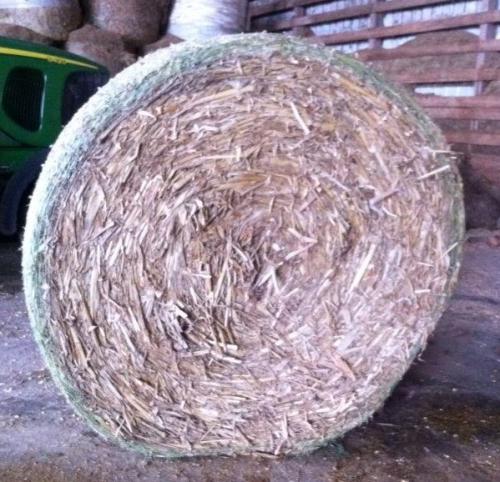The Michigan Corn Stover Project — Part 1: Bale storage study
Recommendations on properly storing corn stover bales if you’re considering harvesting stover.

As the season winds down, farmers have to decide whether or not to harvest their stover. To help assist farmers, the Michigan Corn Stover Project has developed three articles and a bulletin to inform their decision-making process. This article covers the proper way to store corn stover bales.
Key findings
- Storing bales under cover (roof or plastic) reduces storage lost and provides opportunity for long-term storage (more than 120 days).
- Storing bales outside, uncovered, works well though winter, but when it warms up in spring and summer, dry matter losses will increase significantly, particularly with high moisture bales.
The Michigan Corn Stover Project was a collaborative effort at Michigan State University Extension to investigate the uses of corn stover and potential impacts of harvest in Michigan. This effort was comprised of on-farm and small scale research conducted across Lower Michigan. It included a cattle feeding study, integration of a cover crop, bale storage study, harvest time evaluation and the impact of stover removal on yield of the subsequent crop. Funding for the multi-year project was obtained from the Michigan Corn Marketing Board and MSU’s Project GREEEN (Generating Research and Extension to meet Economic and Environmental Needs).

Lower moisture bale at 360 days.
|
Protein, fiber, energy and mineral content of corn stover on day 0 for high moisture and low moisture bales | ||
|---|---|---|
|
|
High moisture |
Low moisture |
|
Dry matter % |
53 ± 2 |
64 ± 4 |
|
Ethanol content % |
18 ± 0.01 |
19 ± 0.01 |
|
Net energy for gain, Mcal/lb |
0.3 ± 0.01 |
0.2 ± 0.03 |
|
Net energy for maintenance, Mcal/lb |
0.53 ± 0.01 |
0.48 ± 0.03 |
|
% Dry Matter | ||
|
Organic matter |
93 ± 0.02 |
95 ± 0.01 |
|
Crude protein |
5 ± 0.3 |
4 ± 0.3 |
|
Crude fiber |
37 ± 0.3 |
42 ± 2 |
|
Acid detergent fiber |
47 ± 0.4 |
52 ± 3 |
|
Total digestible nutrient |
56 ± 0.3 |
52 ± 2 |
|
Ash |
6 ± 1 |
4 ± 0.2 |
|
Calcium |
0.3 ± 0.02 |
0.5 ± 0.04 |
|
Potassium |
0.7 ± 0.1 |
0.6 ± 0.3 |
The objective of the bale storage study was to determine the best storage technique to maintain stover quality. The corn stover round bales were harvested at 45 percent (high moisture) or 22 percent (low moisture) moisture and stored either covered or uncovered. Bales did retain moisture during transportation and storage prior to the start of the study. Corn stover moisture at harvest differed by hybrid type, field location and harvest type. Composite samples were taken from bales with a forage probe on 0, 30, 120, 240 and 365 days in storage. Samples were then analyzed for ash content, theoretical ethanol yield, dry matter, energy, digestibility, mineral content and nutrient recovery.
Corn stover baled for the bioenergy feedstock industry should contain minimal moisture and ash to optimize ethanol yield and dry matter recovery. Results indicated low moisture bales kept structural integrity and had the best results for ethanol production including higher sugar content, higher theoretical ethanol yields and lower ash. This makes uncovered low moisture bales an attractive option from an economical and product quality standpoint.
Higher moisture bales should be stored outside, away from buildings to avoid a fire hazard. Uncovered higher moisture bales maintained nutrient and dry matter through 120 days, making it still feasible to store high moisture bales outdoors for a limited amount of time.
Overall, low moisture bales had better preservation in storage and higher ethanol yield, but less nutrient content compared to higher moisture bales. There was no perceived advantage to storing low moisture bales indoors since the nutrient and dry matter contents were similar over time in storage. Higher moisture bales became very difficult to move after 120 days in storage due to a loss of structural integrity (see photos). Overall, stover bales with lower moisture performed better regardless of intended use or storage type.
For more information on corn stover, please visit our other articles and bulletin:



 Print
Print Email
Email




